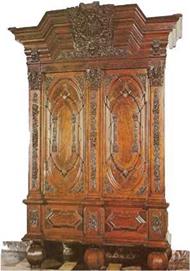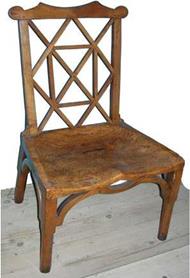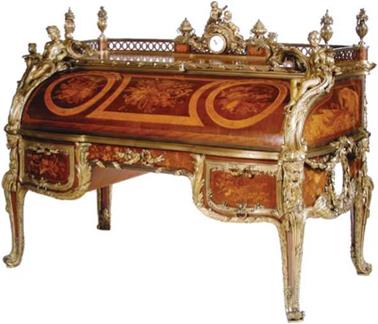French artists and craftsmen perfected the technique of finishing furniture by discovering a terrific black and red furniture lacquer, which imitated Chinese lacquer ideally. Designers put a lot of effort and creative passion into the aesthetics and
Fig. 1.32 Hallway cupboard, beginning of the eighteenth century
 comfort of furniture for sitting: chairs, armchairs, sofas, chaise longues, etc. Finely curved legs of furniture without connectors, rounded corners and smooth lines corresponded harmoniously with delicate tapestry fabrics and wall coverings. During this period, French furniture did not have flat surfaces and straight lines. Thanks to this, the cubic case furniture was enlivened: by profiles narrowing downwards, curved legs and surfaces of hatches, doors and side walls (Fig. 1.33).
comfort of furniture for sitting: chairs, armchairs, sofas, chaise longues, etc. Finely curved legs of furniture without connectors, rounded corners and smooth lines corresponded harmoniously with delicate tapestry fabrics and wall coverings. During this period, French furniture did not have flat surfaces and straight lines. Thanks to this, the cubic case furniture was enlivened: by profiles narrowing downwards, curved legs and surfaces of hatches, doors and side walls (Fig. 1.33).
Instead of dark ebony wood, light-coloured veneers of exotic trees began to be commonly used, such as amaranth, lemon, rosewood, olive, thuja and many others. Furniture surfaces, like in China, were covered using varnishes to such an extent that it almost completely covered the natural drawings of wood with paintings resembling flowery meadows. In particular, these treatments were done to: chests of drawers, night tables, escritoires and screens. Chests of drawers were usually equipped with two deep drawers, while all the visible surfaces were shaped in the form of arcs. Together with the change of tastes of users, the table also changed—it was started to form the legs in an S-shape.
The Rococo chair, not only in shape, but also in dimensions was adjusted to the needs of the user. In particular due to the prevailing fashion of wide women’s dresses, the seat of the armchair was widened significantly, the low armrests spread outwards increased the surface of the seat, which was lined with soft materials. Usually, it was equipped with small cushions called manchettes. The skeletons of these pieces of furniture were made mainly of painted wood or gilded wood on a chalk glue base.
During the period of the French Rococo, an impressive amount of furniture for sitting was created, rich in features, satisfying the specific needs of their owners. Therefore, the following was created: bergere-type armchairs with semicircular armrests upholstered with the backrest, two-person marquises with an elongated
|
Fig. 1.33 Louis XV’s davenport, 1760-1769 |
chaise-longue-like seat, duchesse-type lounges with two full backrests, the higher of which was placed at the side of the head, sofas, ottomans, i. e. small couches with an oval seat, stools, benches and beds without columns. In structure, beds did not differ significantly among themselves in the form of the canopy or the height of case; however, in relation to the beds from the previous period, they were characterised by a visible lightness, as well as a clear differentiation in the men’s and women’s bedroom design.
During the period of Louis XV, for the first time the concept of sets of furniture started to be differentiated. Common in the royal court was the use of a suit, i. e. a set of furniture designed for one room, having a specific function and matching the architecture and colour of the selected interior.
English furniture in the Rococo period was distinguished by enriched ornamental wood carving in the form of the acanthus leaf and human silhouettes and figural animal motifs, including lion heads, masks of satyrs, etc. Around 1725, the backrest form in furniture for sitting changes, which final shape was provided by Chippendale. This transformation was in an openwork forming of the backrest panel to the form of a ribbon ornament, which gave the piece of furniture a lightness that was a fundamental value in Rococo art. The characteristic of this period forms of curved legs and lacquer decorations are credited to the clear Chinese influence on English furniture (Fig. 1.34).
Fig. 1.34 Chair made in Chinese style (cherry), 1760-1800 (Victoria & Albert Museum, London)
 The oldest Chippendale chairs from the front have curved legs, finished with animal claws embracing a sphere. In the upper part, at the joint with cases, they are finished in a straight manner, usually in a baton form or with additional side volutes. The back legs are usually straight or slightly curved. The backrest is openwork, in a rectangular frame, with straight side posts and slightly curved upper joints, which is a characteristic solution for Chippendale-type chairs and what distinguishes them from similar chairs from the previous period (Fig. 1.35).
The oldest Chippendale chairs from the front have curved legs, finished with animal claws embracing a sphere. In the upper part, at the joint with cases, they are finished in a straight manner, usually in a baton form or with additional side volutes. The back legs are usually straight or slightly curved. The backrest is openwork, in a rectangular frame, with straight side posts and slightly curved upper joints, which is a characteristic solution for Chippendale-type chairs and what distinguishes them from similar chairs from the previous period (Fig. 1.35).
Chippendale designed and made almost the majority of structural types of furniture, including chairs, benches, sofas, clocks, beds, cabinets, dressers, bookcases, escritoires, desks and chests of drawers (Fig. 1.36).
During the same period, there was a clear impact of Chinese and Japanese design on the form of furniture produced in London’s manufactures. To finish these pieces of furniture Chinese and Japanese varnishes were used, which were begun to be imported in the seventeenth century.

